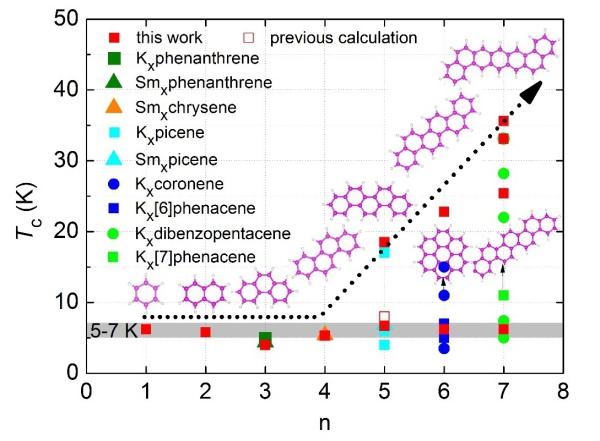Researchers Reveal the Common Feature and the Enhancement Mechanism of Aromatic Hydrocarbons Superconductor
The discovery of superconductivity above 100 K in aromatic hydrocarbons has been an exciting event in condensed matter physics, chemistry, and materials in these years.
Superconductivity was realized by simply introducing electrons in the network made by carbon and hydrogen - the two components for organic systems.
However, the accurate amount of doped electrons and their positions haven’t established experimentally. No agreement has reached for the mechanism of their superconductivity.
Prof. ZHONG Guohua at the Shenzhen Institutes of Advanced Technology (SIAT) of the Chinese Academy of Sciences, collaborated with Prof. LIN Haiqing from the Beijing Computational Science Research Center and Prof. CHEN Xiaojia from the Center for High Pressure Science and Technology Advanced Research, studied the structures and physical properties of aromatic hydrocarbons systematically and addressed these problems by the first-principles theory with the combination of the electron correlations method.
The results showed that both the single-ring compound (benzene) and the two-benzene rings compound (naphthalene) were superconductors with transition temperatures (Tc’s) of 6.2 K and 5.8 K respectively after doing potassium. By examined the theoretical predictions and summarized the existing experimental data, the researchers found that there exists a unique superconducting phase with Tc in the range of 5K-7K for all aromatic hydrocarbons. The low density of states at Fermi level induced by about two electrons doping is the origin of this unified phase with low-Tc. The high density of states at Fermi level upon three-electron doping seems responsible for the high-Tc phase in these hydrocarbons with long benzene rings. Meanwhile, the electronic correlations increased as well when the number of benzene rings increased.
Researchers suggested that both the electron-phonon interactions and electron-electron correlations works together to enhance the Tc. These findings offer clues to the understanding of the superconductivity as well as to the search of new superconductors in this family.
The paper “Superconductivity and its enhancement in polycyclic aromatic hydrocarbons” was published on the Frontiers in Physicas on April 2019.

Fig. Variation of superconducting transition temperature Tc with the number of benzene rings (n) for various aromatic hydrocarbons. (Image by Prof. ZHONG Guohua)
CONTACT:
ZHANG Xiaomin
Email: xm.zhang@siat.ac.cn
Tel: 86-755-86585299
| Download the attachment: |
|
|